We have much more to do and your continued support is needed now more than ever.
A Safety Net for Butterflies

It’s Learn About Butterflies Day! When that first butterfly of spring flutters by, our hearts skip a beat. Sadly, almost a fifth (17 percent) of the roughly 800 species gracing the United States are at risk of extinction. The number could be higher, but we desperately lack more information.
Butterflies matter for even more than their beauty. They pollinate flowers. Their caterpillars are essential food for songbird chicks. And consider this, butterflies have been around for at least 50 million years. They know how to navigate most everything, but us.
The good news? The Recovering America’s Wildlife Act will give butterflies a safety net by funding state wildlife agencies to take actions that help species in crisis recover and thrive. Do you want to see a world filled with wildflowers and dotted with the likes of swallowtails, fritillaries, buckeyes, admirals, and monarchs? Tell your representative in Congress to take action today.
Act NowAt this moment, many butterflies in addition to the famous monarch, are migrating northwards gradually from Mexico or southern states. Painted ladies, red admirals, cloudless sulphurs, and fiery skippers are among the radiant migrants flecking the skies. Their return is nothing short of miraculous, given human-caused hazards they face –from pesticides to paved-over prairies. Like the monarchs, their safety net lies in natural habitats with nectar-rich wildflowers to fuel their journey and the right host plants to lay their eggs.
Hand a Prairie Violet Bouquet to the Regal Fritillary
One of the butterflies on the brink that the Recovering America’s Wildlife Act will greatly help is the regal fritillary. This stunning butterfly of the central and eastern U.S. depends on dwindling tallgrass and mixed-grass prairies, and the native prairie violets that grow there. Regal fritillaries sip nectar from thistles, milkweeds and other wildflowers. They lay their eggs on prairie violets in late summer. The caterpillars hatch in fall and hide under leaf litter for the winter. They delay growing until spring, when they emerge to feast on the leafy violets.
Already state wildlife agencies are making a difference in Pennsylvania, managing remaining wild prairies to assure both butterflies and violets thrive. By fully funding State Wildlife Action Plans through The Recovering America’s Wildlife Act, states across the Northeast will work together to restore and reestablish prairie communities for regal fritillaries.
Time is short. Once found across 32 states, the regal fritillary has vanished from 14, and is in peril in all others, except Kansas.
Thanks for celebrating Learn About Butterflies Day by taking action to help save them!





















